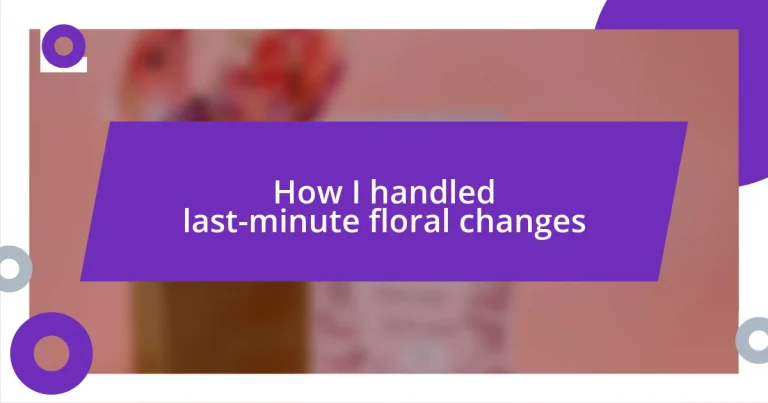Key takeaways:
- Assessing and prioritizing floral needs through open communication with clients can transform last-minute changes from stressful situations into collaborative opportunities.
- Embracing creativity and being open to alternative flower options can lead to unexpected and delightful results, enhancing overall designs.
- Establishing strong supplier relationships and maintaining an organized, flexible schedule are crucial for ensuring timely delivery, even amidst last-minute adjustments.
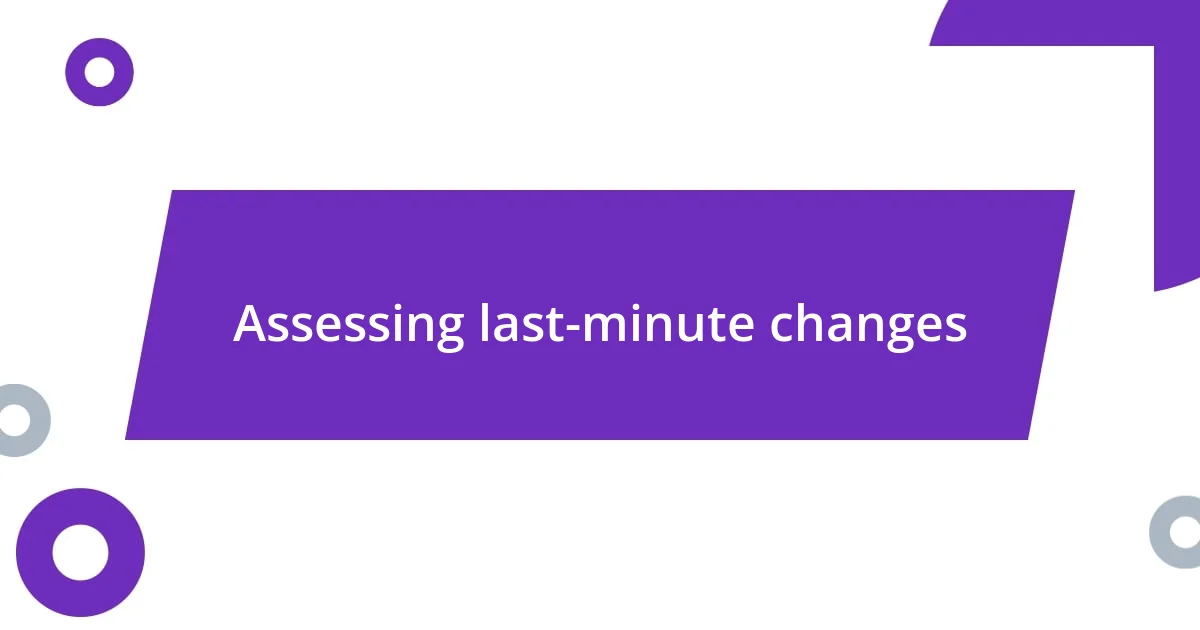
Assessing last-minute changes
When I face last-minute floral changes, I start by taking a deep breath. Have you ever felt that rush of panic when something doesn’t go as planned? I remember a wedding where the bride changed her mind about the bouquet just hours before the ceremony. It was a small moment, but I realized that assessing what’s necessary can shift the focus from stress to solutions.
Next, I prioritize what matters most. Do the flowers still align with the overall theme? In that same wedding scenario, I quickly gathered the remaining blooms and assessed their colors and shapes. I often think about how a key flower can become a focal point in a design. Understanding these dynamics allows me to make informed decisions amidst the chaos.
Lastly, keeping communication open with clients is vital. I once had a frantic call from a bride who wanted vibrant colors instead of pastels. I took the time to understand her vision, which ultimately turned a stressful moment into an exciting collaboration. Have you ever navigated a sudden change that ended up being better than the original plan? It’s these instances that remind me how adaptability can lead to beautiful outcomes.
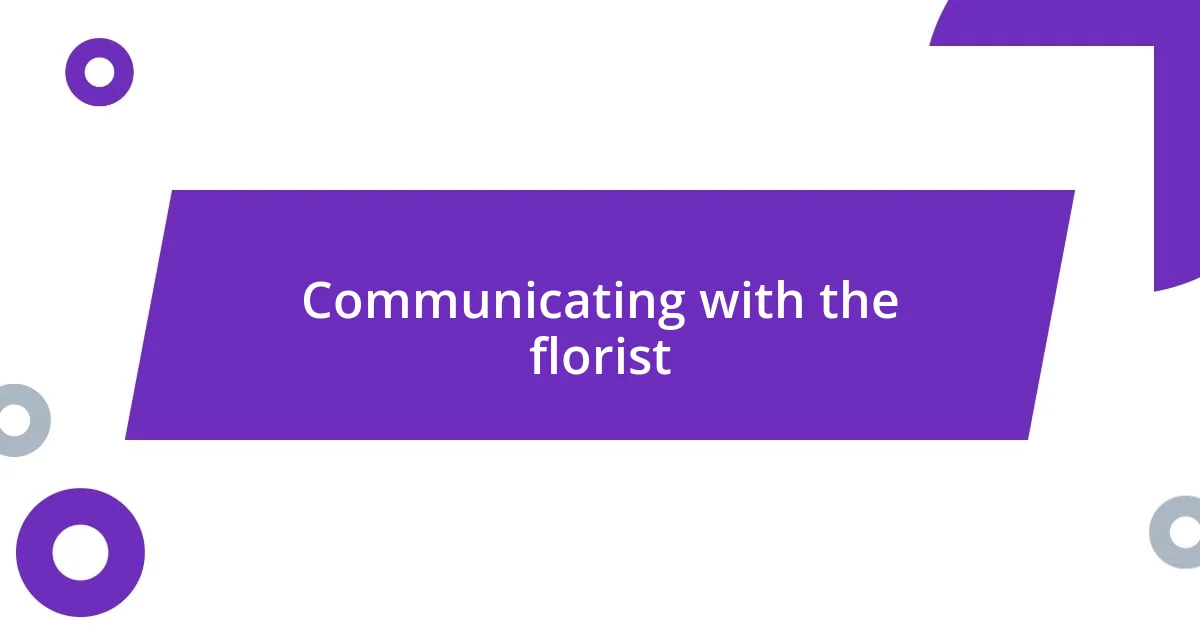
Communicating with the florist
Communicating effectively with the florist is essential when last-minute changes arise. I recall a particularly hectic day when a bride texted me just two hours before her ceremony, insisting on a complete floral overhaul. My heart raced, but I knew keeping calm and contacting my florist was crucial. I explained her new vision clearly, emphasizing the need for bright, cheerful blooms to reflect her personality.
- Be specific about your needs and desires.
- Keep the lines of communication open; don’t hesitate to reach out.
- Share any changes in the theme or color palette.
- Establish a mutual understanding of timelines and availability.
Clarity in communication can transform a frazzled situation into a seamless solution. When my florist heard the urgency, she suggested alternatives we hadn’t considered, proving that collaboration is key. I’ve found that by working closely with my florist, we not only create beautiful arrangements but also build a trusting partnership, which ultimately enhances the wedding experience for everyone involved.
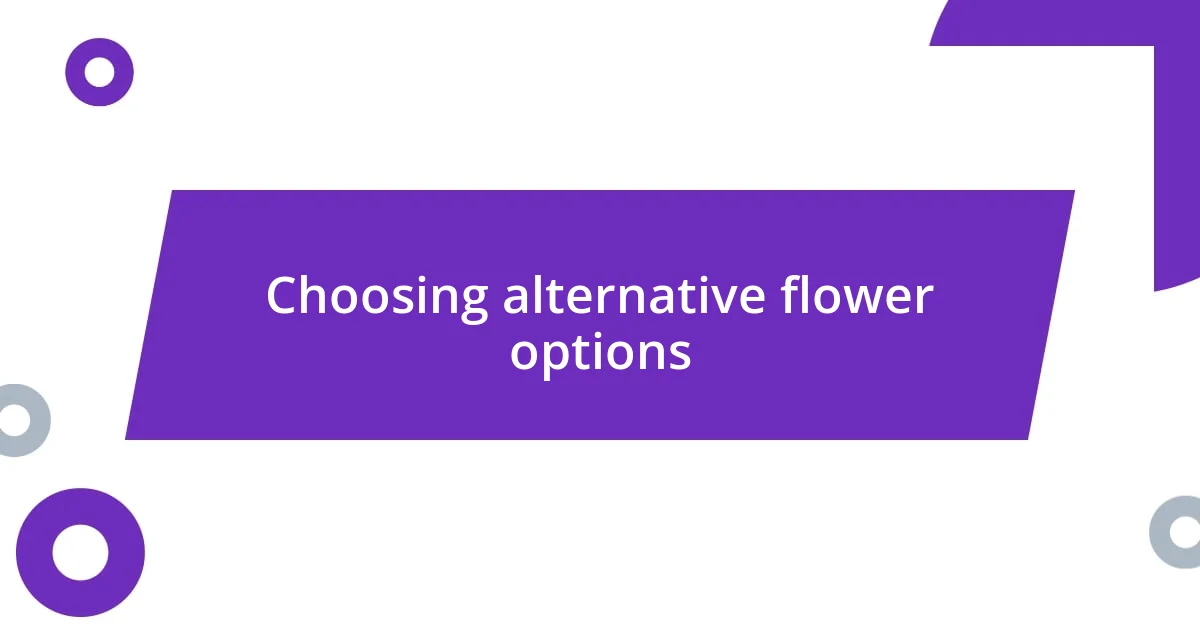
Choosing alternative flower options
Choosing alternative flower options can be a creative challenge during last-minute changes. I’ve learned that sometimes the most unexpected blooms can make for a stunning replacement. For instance, I once had a couple requesting peonies, but they were out of season. Instead of panicking, I explored alternatives like garden roses that offered the same lush, romantic feel, and honestly, the couple loved the unexpected twist! This experience showed me that keeping an open mind can lead to delightful surprises.
When considering alternatives, it’s essential to think about color and texture. I recall a time when a bride’s favorite flower was no longer available, so I turned to seasonal options that could easily complement her original vision. I chose vibrant dahlias instead, which not only matched her color palette but also added a unique texture to her bouquet. This adaptability helped keep the overall design cohesive and beautiful—something that I always strive for when working with clients.
Understanding flower characteristics is important in these situations as well. For example, if you’re replacing delicate flowers with something sturdier, consider how they will look and last throughout the event. I once had to switch out a delicate lily for a robust sunflower. While it was a bold move, the sunflower brought a joyful brightness to the arrangements that perfectly captured the couple’s fun-loving spirit. Knowing the traits of your options can make all the difference.
| Original Flower | Alternative Flower |
|---|---|
| Peonies | Garden Roses |
| Lilies | Sunflowers |
| Hydrangeas | Roses |
| Dahlias | Zinnias |
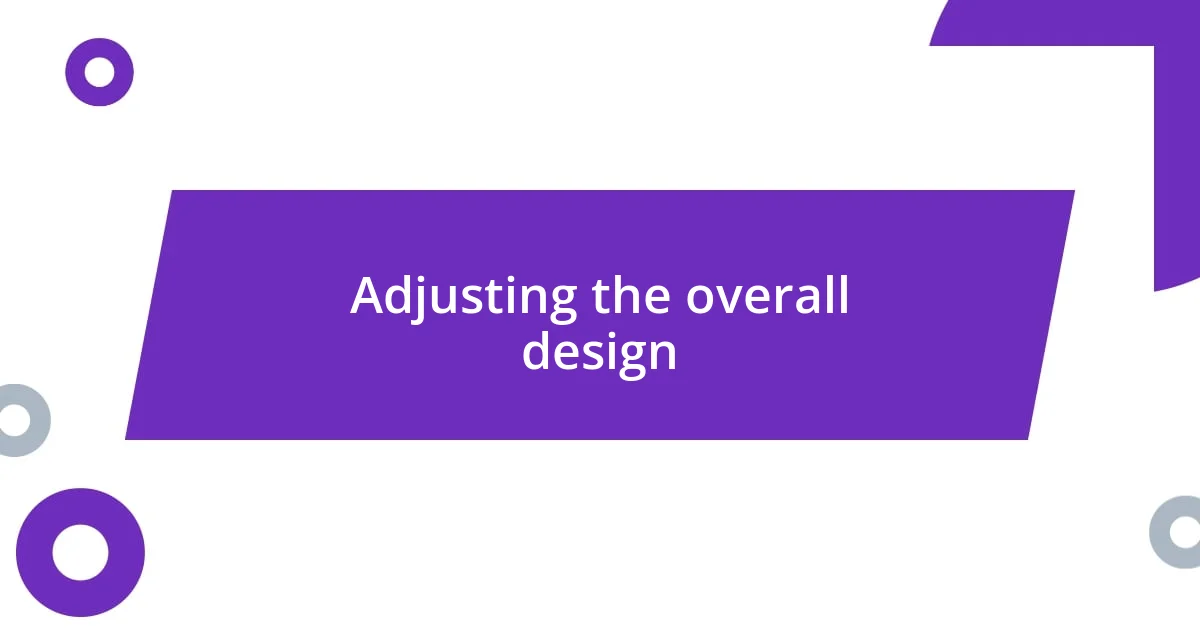
Adjusting the overall design
Adjusting the overall design in response to last-minute changes can feel daunting, but it’s also an opportunity for creativity. I remember a stunning wedding where, just hours before the event, we needed to replace the main centerpiece flowers because of a supply issue. Instead of succumbing to stress, I embraced the challenge. By thinking about the overall color scheme and mood, we opted for a mix of sunflowers and wildflowers. The shift not only brightened the entire room but brought a laid-back, joyful vibe that the couple adored.
When tweaking the overall design, I’ve found it’s not just about replacing flowers but reimagining the entire aesthetic. I once had a bride who initially wanted an elegant arrangement with white roses and greenery. At the last minute, she requested more vibrant colors. I encouraged her to think about how to incorporate bold shades to keep that elegant feel. Together, we created a stunning fusion of coral and fuchsia blooms, which transformed her vision into a vibrant celebration. Watching her excitement as the arrangement blossomed into something completely new was a reminder of how flexible our designs can be.
It’s remarkable how a small adjustment can shift the entire atmosphere of an event. In one case, we changed the vases from classic glass to rustic wood. Just that simple switch changed the entire feel—from formal to inviting. I often ask myself, “How can this change enhance the joy of the day?” By treating every last-minute adjustment as a chance to elevate the design rather than a setback, I’ve learned to not just adapt but thrive in those unpredictable moments.

Managing expectations with clients
Managing expectations with clients during last-minute changes is crucial, and I’ve found that clear communication is the foundation of that. I remember a particularly hectic wedding week when a bride informed me the day before her wedding that her dream flowers were no longer available. Rather than letting her panic escalate, I calmly discussed alternatives and ensured she felt involved in the decision-making process. By framing the conversation around possibilities rather than limitations, I helped transform her initial disappointment into excitement about new options.
Setting realistic expectations can also alleviate stress. In another instance, a couple was set on having delicate orchids as their ceremony decor. When I had to break the news about their unavailability, I suggested switching to more robust zinnias with a similar color scheme. The couple was initially hesitant, but once they saw the vibrant arrangements come together, their apprehension turned into delight. It’s moments like these that remind me of the importance of framing changes in a positive light while providing reassurances about the beauty of the final outcome.
I often think about how important it is to be transparent with clients while also showcasing my expertise. When discussing potential floral changes, I share not just my opinions but also the reasoning behind those alternatives. For example, I once explained how peonies bloom beautifully even in small arrangements, providing a lush look without overwhelming the design. This not only educated the clients but also empowered them to embrace the changes, making them feel like decision-makers in their own floral journey. What I’ve learned through these experiences is that a little empathy and openness can turn a potentially stressful situation into a collaborative adventure.

Ensuring timely delivery
Ensuring timely delivery in the floral business, especially when juggling last-minute changes, can be a real balancing act. I remember one event where we had to switch flower varieties just a few hours before delivering. I quickly coordinated with my suppliers, emphasizing the urgency of the situation, which truly underscored the importance of building strong relationships in this industry. These relationships often mean that when you make a call, people are ready to jump in and help.
One strategy I’ve found effective is keeping an organized schedule with built-in flexibility. When a bride suddenly requested a change in her bouquet style two days before her wedding, I had already set aside time for any unexpected adjustments. I swiftly gathered my team, and we brainstormed together, bringing in fresh, local blooms that would enhance her original vision. It felt rewarding to see her reaction when I delivered the bouquet; the joy on her face reminded me that being prepared is just as vital as being adaptable.
Sometimes, I find myself asking, “How can I ensure everything arrives on time and looks beautiful?” The secret often lies in my meticulous attention to detail. Even during those chaotic moments, I conduct a final check against my checklist; it’s a simple thing, but it saves me from potential mishaps. I’ve learned that not only does this keep my workflow smooth, but it also builds trust with my clients. Knowing they can rely on me for timely delivery turns what could be a nerve-wracking experience into one of confidence and joy.

Lessons learned for future events
In reflecting on last-minute floral changes, I’ve realized the immense value of having a backup plan. Once, during a large gala, a crucial delivery fell through right before the big event. Instead of panicking, I had already prepped extra arrangements from a previous order. It felt like a mini miracle as those unexpected blooms turned out to be show-stoppers, teaching me that foresight can be a lifeline in a pinch.
Another lesson I’ve taken to heart is the importance of cultivating creativity under pressure. I recall a time when all the requested deep purple flowers were suddenly unavailable, and I had to brainstorm on the spot. I decided to incorporate lush greens and vibrant oranges instead. The end result not only met the vibrant color theme but also evoked a sense of joy and energy that left everyone raving. Isn’t it incredible how constraint can fuel innovation?
Lastly, I’ve learned that embracing the unexpected can lead to delightful surprises. During an outdoor wedding, a sudden rain shower changed our initial setup completely. Instead of a manicured floral arch, we transitioned to a cozy, enchanting tent filled with blooms in vibrant hues. The couple later expressed how this spontaneous change added warmth and intimacy to their day. So, I often wonder: how can we transform moments of stress into opportunities for magic? In my experience, it’s all about maintaining a positive mindset and being open to new possibilities.












